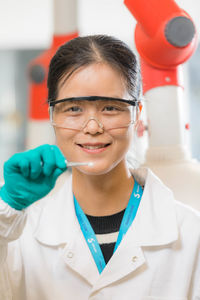Dr. Jianxia Zheng
E2P2L - IRL3464 CNRS - E2P2L Director
Syensqo (China) Co., Ltd.
3966 Jin Du Rd.,
Xin Zhuang Industrial Zone, Shanghai 201108, China
E-mail: jianxia.zheng@syensqo.com
Tel.:+86 21 2350 2212
Cell: +86 150 2188 1324
Dr. Jianxia Zheng is director of Syensqo's R&I laboratory in China. The E2P2 laboratory is an international joint lab dedicated to eco-innovation and sustainable chemistry. It regroups 8 partners, CNRS, Syensqo, ENS Lyon, Lille University, University of Poitier, ECNU, Fudan University and ECUST. High level researchers focus on developing new environmentally benign catalytic solutions.
After her PhD in organometallics and catalysis received at the University of Rennes 1, France, she moved first to International Flavors and Fragrances Company in Hangzhou as process research engineer then at Syensqo E2P2 laboratory in Shanghai as research scientist in October 2017. Jianxia has more than 8 years experience in leading international Research and Innovation projects. Her experience includes process development and scaling up, project management, and external collaborations. As an expert in catalysis and organic Chemistry, she published several peer-reviewed papers and is also the inventor of several patents.
Dr. Jeremie Zaffran
E2P2L - UMI 3464 CNRS Researcher
Solvay (China) Co., Ltd.
3966 Jin Du Rd.,
Xin Zhuang Industrial Zone, Shanghai 201108, China
E-mail: jeremie.zaffran@cnrs.fr
Tel.:
J. Zaffran got his PhD at Ecole Normale Superieure de Lyon (ENSL) in France in 2014, under the supervision of Prof. Philippe Sautet in the field of molecular modelling applied to heterogeneous catalysis. After a Postdoctoral fellowship at the Technion-Israel Institute of Technology (IIT) in Israel, followed by a research stay at ShanghaiTech University in China as a Research Assistant Professor, he joined the National French Research Center (CNRS) as a full Researcher in 2020 at Eco-Efficient Products and Process Laboratory (E2P2L), an international joint unit between the CNRS and Syensqo Industries.
J. Zaffran expertise area is related to the development of predictive models combining density functional theory (DFT) calculations and machine learning (ML), in order to fast predict surface reactivity. This computational catalyst design approach is expected to provide a significant help to experimentalists, significantly speeding up the catalyst formulation process. So far, J. Zaffran is the author of more than twenty publications in peer-reviewed journals with high impact factors. His research has many fields of application, from biomass and CO2 conversion into valuables to photoactive electrodes for photoelectrochemical devices and fuel cells.


